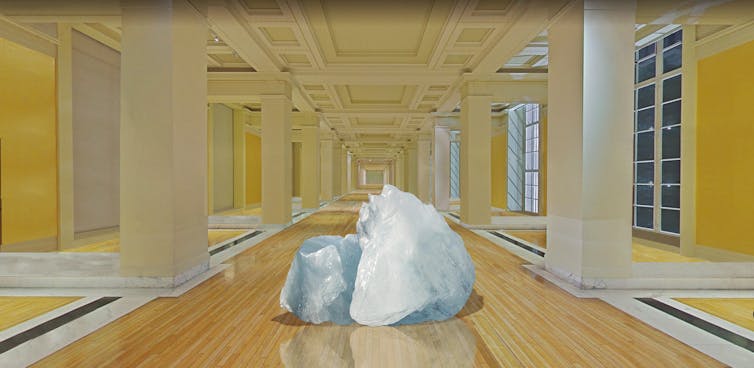It’s been an interesting year on The Conversation Insights desk. We’ve produced a raft of compelling stories from academics carrying out research all over the world in an attempt to answer some of life’s most important questions.
Whether it’s a millionaire bunker builder living in a revamped intercontinental ballistic missile silo in Texas or a doctor on the frontline of the coronavirus pandemic in Liverpool, our long reads have featured fascinating people with amazing tales to tell.
There have been stories of innovation and pure joy, intensely personal journeys as well as in-depth, data driven analysis.
This being 2020, there have also been stories tinged with sadness. But what all our stories have in common is a sense of hope. Here are some of our personal highlights.

This article is part of Conversation Insights
The Insights team generates long-form journalism derived from interdisciplinary research. The team is working with academics from different backgrounds who have been engaged in projects aimed at tackling societal and scientific challenges.
Paul Keaveny, Commissioning Editor, Insights
Dickensian sleuth Leon Litvack brought us a world exclusive after delving into archives and cathedral vaults to find letters and documents that revealed how Charles Dickens’s biographer and friend John Forster conspired with the dean of Westminster Abbey to clinch the author a “fitting” celebrity funeral – against the writer’s will and his family’s wishes.
Read more:
Charles Dickens: newly discovered documents reveal truth about his death and burial
Bradley Garrett took us through the three years he spent with some of the world’s most committed doomsday preppers and bunker builders who took quarantine and self-isolation to the next level.
Read more:
Living with bunker builders: doomsday prepping in the age of coronavirus

When historian Eyal Poleg and scientist Paola Ricciardi uncovered a hitherto unknown plot by Thomas Cromwell to “cut and paste” his image next to the King on Henry’s Great Bible, they were blown away. So were we, and so was Wolf Hall writer, Hilary Mantel. After she read our piece, she told us: “It raises fascinating questions about the relationship between Henry’s leading ministers, and suggests that the politicians of the 16th century were as capable of manipulation of images as those of the present day.”
Read more:
How Thomas Cromwell used cut and paste to insert himself into Henry VIII’s Great Bible
Josephine Lethbridge, Interdisciplinary Editor
Back in March, as much of the world faced lockdown for the first time, economist Simon Mair pondered over what a post-coronavirus future might hold. How bad will this crisis turn out to be? What problems has it brought to light? Might it be used as a chance to rebuild better? March now seems like a very long time ago, but his projections of four possible futures remain relevant – and somewhat hopeful.
Read more:
What will the world be like after coronavirus? Four possible futures
Charlotte Wrigley asked us to imagine a very different future, one where resurrected mammoths might trample down the permafrost in Siberia’s tundra, thereby counteracting the terrible effects of climate change. She spent a few months with Sergey and Nikita Zimov, the father and son spearheading this madcap plan, while researching the effects of thawing permafrost. This took her to mammoth museums, cryobanks and a winter on the ice along the way.
Read more:
Mammoth task: the Russian family on a resurrection quest to tackle the climate crisis
This year was, after all, supposed to be a year that focused on the climate crisis. But of course, the 2020 United Nations Climate Change Conference was postponed until 2021. Attendees next November will find another futuristic vision we’ve covered there – an exhibit of some speculative “museums of the future” that might encourage visitors to reflect on humanity’s damaging relationship with nature – and, hopefully, do something about it.
Read more:
Climate crisis: how museums could inspire radical action

Image courtesy John Zhang and Studio JZ, Author provided
Megan Clement, Commissioning Editor, COVID-19
After months of covering the horror of the early stages of the coronavirus pandemic, we were desperate for a glimpse of hope. In autumn, that came in the form of an ear, nose and throat surgeon in Nottingham, who wrote to The Conversation to tell us that he and his colleagues had invented a new form of PPE.
Why? So they could continue carrying out life-changing surgery on deaf children. His story, along with the delightful pictures of trying to mimic surgery while wearing a scuba mask, lifted the spirits of our editors and readers alike.
Read more:
Coronavirus stopped us doing life-changing surgery, so we invented a new form of PPE
As the year drew to a close, we heard from another set of healthcare workers who wanted to share their stories. Two infectious disease doctors, Tom Wingfield and Miriam Taegtmeyer, wrote about the challenges and successes of caring for COVID patients in the hospitals of Liverpool during the second wave of coronavirus. Their moving testimony, including tributes to lost colleagues and recovered patients, will stay with me throughout the winter.
Read more:
‘We will not forget our colleagues who have died’: two doctors on the frontline of the second wave
Rob Reddick, Commissioning Editor, COVID-19
The decision to prioritise vaccinating care home residents in the UK shows that the risk of COVID-19 in care settings is finally being taken seriously. But the high vulnerability of people in care seemed to come as a surprise in the first wave. It shouldn’t have.
As Chris Wilson’s archival research showed, a Victorian cholera epidemic provided a chilling preview of what happens when there are inadequate precautions to stop a disease getting into an institution of care. Hopefully this example, and those of 2020, will ensure that sufficient protections are always in place in the future.
Read more:
The eerily similar pandemic we could have learned from but didn’t

For you: more from our Insights series:
- Searching for Misha: the life and tragedies of the world’s most famous polar bear
- What developing countries can teach rich countries about how to respond to a pandemic
- How worried should we be about the coronavirus resurgence in Europe? Three experts weigh in
To hear about new Insights articles, join the hundreds of thousands of people who value The Conversation’s evidence-based news. Subscribe to our newsletter.
![]()











